It is important to understand and monitor the overall health and survival rate of the herd. The condition of individual animals, any diseases or outbreaks, and predators that kill caribou can all contribute to herd health.
Health
Body Condition
Each year, hunters are asked to take samples from some of the caribou they harvest in the fall and measure the amount of fat on the animals. Observations from hunters and other people on the land are also collected and incorporated into monitoring efforts. This helps to estimate the overall health of animals in the Porcupine Caribou herd.
Diseases and Parasites
Parasites and diseases are a natural part of any wildlife population. However, if there is a change in the frequency of occurrence or if the environment changes, the effects of these parasites and diseases may become more important to the caribou. If you are harvesting caribou and you see anything odd, carefully take a sample (wear gloves if you can) and keep it cool or frozen. Contact your regional biologist or conservation officer and they will help get it tested.
Tapeworms
Caribou can act as hosts to different types of tapeworm larvae. The larvae will grow in cysts in the caribou, but won’t kill them. However, if a wolf or dog eats the cysts, the larvae will grow into tapeworms inside them. The worm’s eggs are then passed through the animal’s feces. If humans come in contact with the eggs, either through handling of feces or drinking contaminated water, the eggs can hatch and a tapeworm will grow inside of them and pose serious health risks.
Here are three common types of tapeworms larvae found in porcupine caribou:
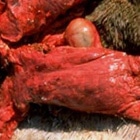
Echinococcus granulosis
Cysts found in the lungs of caribou.
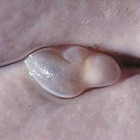
Taenia hydatigena
Cysts found in the livers of caribou.
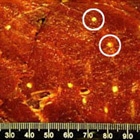
Taenia krabbei
Cysts found in the muscles and hearts of caribou.
Thread Lungworms
The larvae of these lungworms are passed on through the feces of infected animals and is transferred to others who might be grazing in the same area. If ingested, the larvae migrate to the caribou’s lungs where they grow and eventually lay eggs that pass through the caribou and start the cycle again. Caribou that have lungworms can get pneumonia and can generally be in a weakened state.
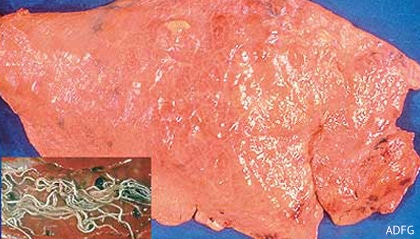
Cornmeal Disease
This is a parasite that occurs in caribou and reindeer. It can cause a roughening or pitting of bones and tendons in caribou. Caribou with the parasite often have hair loss and areas of thick or crusty skin. Most infected animals do not seem overly affected by the parasite. It does not appear to affect humans.
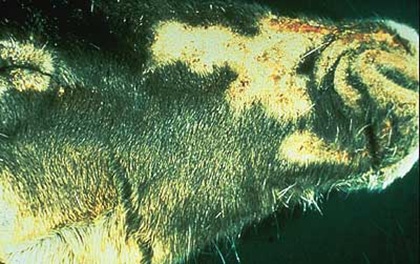
Brucellosis
This is a bacterial disease that is transmissible to humans by caribou. In female caribou, the infection can cause abortion, retained afterbirth (which may cause infection) and giving birth to weak calves with a poor prognosis for survival. Humans can be infected by milk, fetuses or the body organs and marrow from infected caribou. The flu-like symptoms can be severe, and hospitalization might be required.
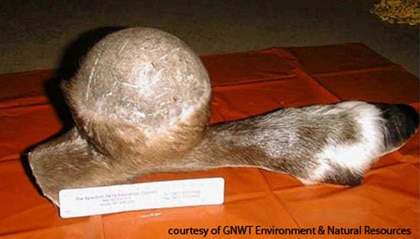
Warbles
Adult warble flies lays eggs in hair of caribou. The larvae hatch, penetrate the skin, and travel under the skin to the caribou’s back. The warbles grow there until early summer, when they break through the skin and drop to the ground. The warbles can cause infection and weaken the infected animal.
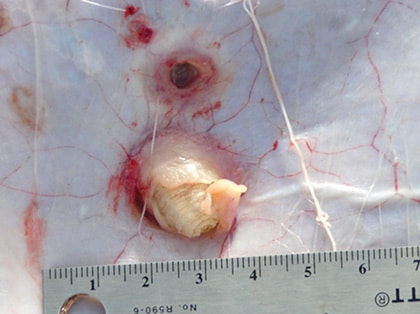
Nasal bots
These are the larvae of bot fly and grow in caribou’s nostrils. They can cause nasal discharge and coughing and may block breathing, but their effect on the overall body condition of the caribou is unclear.
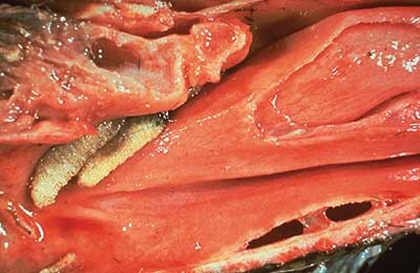
- Tapeworms
-
Tapeworms
Caribou can act as hosts to different types of tapeworm larvae. The larvae will grow in cysts in the caribou, but won’t kill them. However, if a wolf or dog eats the cysts, the larvae will grow into tapeworms inside them. The worm’s eggs are then passed through the animal’s feces. If humans come in contact with the eggs, either through handling of feces or drinking contaminated water, the eggs can hatch and a tapeworm will grow inside of them and pose serious health risks.
Here are three common types of tapeworms larvae found in porcupine caribou:
Echinococcus granulosis
Cysts found in the lungs of caribou.
Taenia hydatigena
Cysts found in the livers of caribou.
Taenia krabbei
Cysts found in the muscles and hearts of caribou.
- Thread Lungworms
-
Thread Lungworms
The larvae of these lungworms are passed on through the feces of infected animals and is transferred to others who might be grazing in the same area. If ingested, the larvae migrate to the caribou’s lungs where they grow and eventually lay eggs that pass through the caribou and start the cycle again. Caribou that have lungworms can get pneumonia and can generally be in a weakened state.
Thread Lung Worm - Cornmeal Disease
-
Cornmeal Disease
This is a parasite that occurs in caribou and reindeer. It can cause a roughening or pitting of bones and tendons in caribou. Caribou with the parasite often have hair loss and areas of thick or crusty skin. Most infected animals do not seem overly affected by the parasite. It does not appear to affect humans.
Besnoitia tarandi - Brucellosis
-
Brucellosis
This is a bacterial disease that is transmissible to humans by caribou. In female caribou, the infection can cause abortion, retained afterbirth (which may cause infection) and giving birth to weak calves with a poor prognosis for survival. Humans can be infected by milk, fetuses or the body organs and marrow from infected caribou. The flu-like symptoms can be severe, and hospitalization might be required.
Brucellosis - Warbles
-
Warbles
Adult warble flies lays eggs in hair of caribou. The larvae hatch, penetrate the skin, and travel under the skin to the caribou’s back. The warbles grow there until early summer, when they break through the skin and drop to the ground. The warbles can cause infection and weaken the infected animal.
Warbles - Nasal bots
-
Nasal bots
These are the larvae of bot fly and grow in caribou’s nostrils. They can cause nasal discharge and coughing and may block breathing, but their effect on the overall body condition of the caribou is unclear.
Nasal bots
Contaminants
Contaminants are not a significant problem for Porcupine Caribou or humans who consume them. For more information visit the Arctic Caribou and Moose Contaminant Monitoring Program website.
